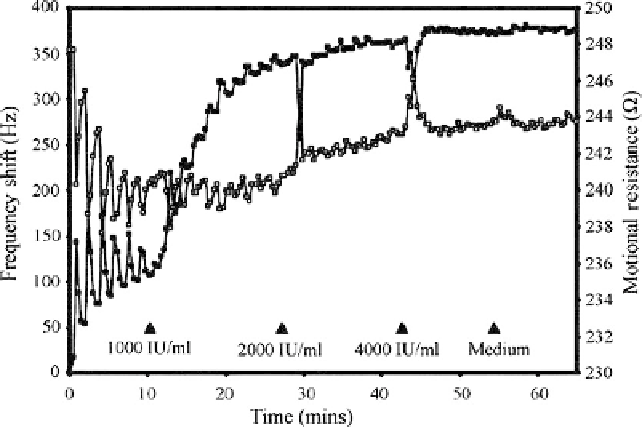Biomedical Engineering Reference
In-Depth Information
d
n
4
t
3
n
g
|
2
Figure 5.12
Effect of neurotrophic betaferon on a neuron population immobilized on
a TSM surface. Synchronous oscillations are detected both on the
resonant frequency (dark squares) and motional resistance (open
squares).
22
(Reprinted by kind permission of the Royal Society of Chemistry.)
n
3
.
The acoustic response of the TSM-attached neurons to betaferon is shown in
Figure 5.12. Interestingly, the resonant frequency decreases considerably with
little effect being observed for the response in resistance. Furthermore, the two-
minute period oscillations apparent before introduction of the drug are damped
as a result of interaction with betaferon. (Such oscillations are discussed in
more detail in the next section.) Several questions are posed by these obser-
vations. First, experimental work has shown that the confluence of the cells on
the device surface is important, presumable in terms of cellular communication.
Second it is not clear how the molecule is affecting the behavior of the cells
and, indeed, what is the true nature of the acoustic response to this process.
This preliminary work has stimulated a significant effort to connect the acoustic
response of neurons to cellular behavior at a fundamental level.
Depolarization of cultured hypothalami, at a confluence level in the range
80-100%, using the TSM system was recently examined.
23
This phenomenon is
dependent on voltage-gated Na
1
and delayed K
1
channels. Normally, a
stimulus that causes sucient depolarization causes voltage-gated Na
1
channels to open and cause further depolarization (self-amplifying process)
until the Na
1
equilibrium potential is reached. At this point, two mechanisms
act in concert, namely the inactivation of the Na
1
channels and the opening of
the K
1
voltage-gated channels to restore the cell to its resting potential.
Stimulation by the addition of KCl resulting in cellular depolarization has long
been examined by conventional patch-clamp techniques. It is suggested that an
addition of KCl affects the electrochemical gradient of K
1
, resulting in a slower

